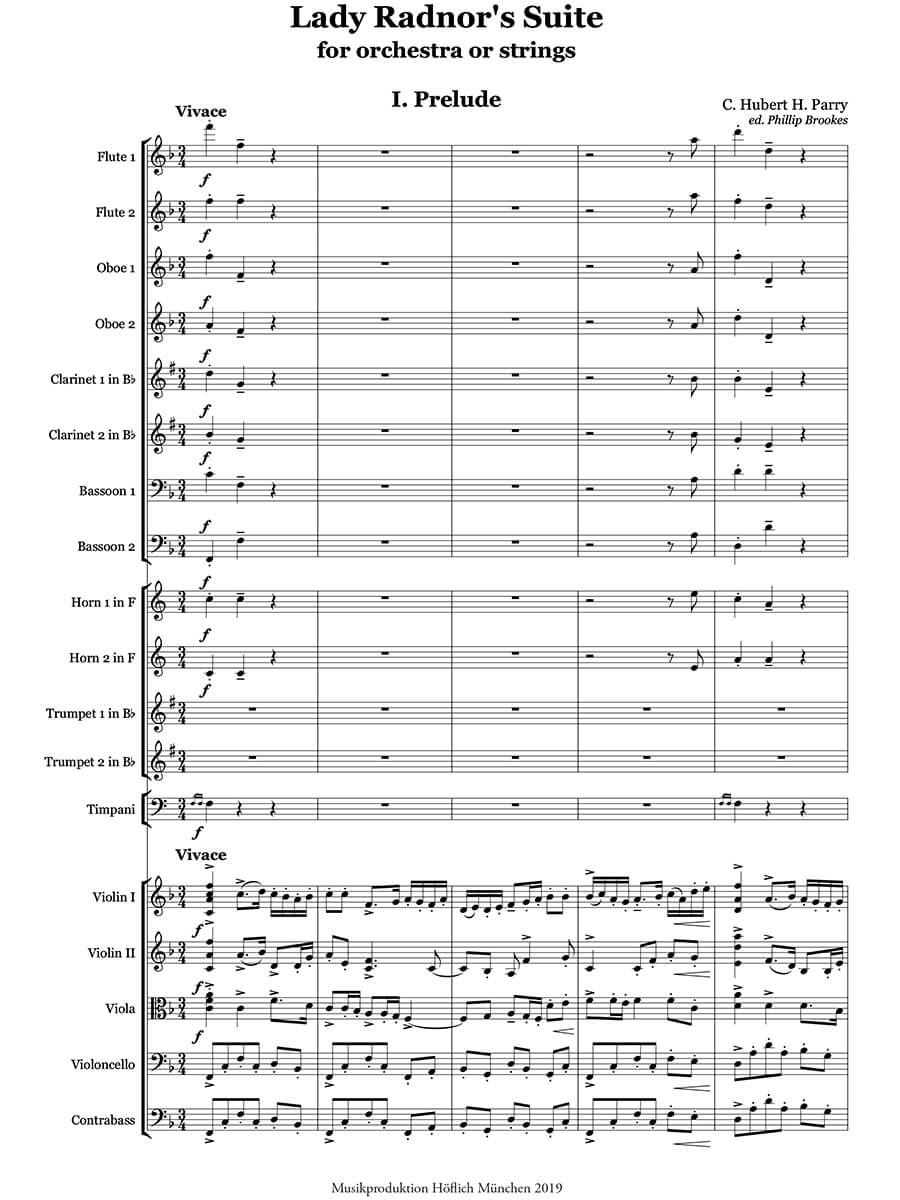Lady Radnor’s Suite for orchestra or strings (first print)
Parry, Charles Hubert
22,00 €
Charles Hubert Hastings Parry – Lady Radnor’s Suite for orchestra or strings
(b. Bournemouthm, 27. February 1848 – d.. Rustington, 7. Oktober 1918, Rustington)
Prelude, p.1
Allemande, p.15
Sarabande, p.23
Bourée, p.29
Slow Minuet, p.39
Gigue, p.46
Preface
Helen, Countess of Radnor, was a friend of Parry’s through his wife Maude, who herself was a daughter of the Earl of Pembroke. Lady Radnor was a gifted amateur musician, with a reputation as a conductor. In 1893 she asked Parry if he would write something for an all-female string orchestra she had founded. Parry was delighted to do so, and the suite was first played on 29 June 1894 by a 72-piece string orchestra conducted by Lady Radnor. Novello & Co. soon published it, and Lady Radnor’s Suite has become a staple of the string orchestra repertoire.
But Parry clearly had in mind the possibility of a wider interest than string ensembles, for he wrote parts for pairs of flutes, oboes, clarinets, bassoons, horns and trumpets as well as timpani into the autograph score. He even wrote a long cue (in coloured ink) in the string parts to be played in the absence of wind. (The passage is at letter G in the Sarabande.) In the event Novello declined to publish the suite for anything but strings, though they did keep a set of the wind for hire. It is not thought that anyone ever hired the wind, and the first performance of the orchestral version may have been in 1993, by the Market Drayton Orchestra conducted by Phillip Brookes. This edition gives the complete score as Parry wrote it, but he was a very busy man, and wrote quickly – this is always apparent from his autograph scores. The suite may be played either by a classical-sized orchestra or – with the relevant cues – by strings alone. The wind parts have been edited in minor ways: small changes have been made to make expression and articulation marks consistent between parts. The problem sometimes arises of inconsistencies between parts – should the flute be mf, or p, like the rest of the wind? –it is not always clear whether Parry wanted the differences, or simply was too hasty to check everything. Also, he added the timpani part almost as an afterthought in the original, writing it in pencil at the foot of each page, and it is not always clear what is required. Some attempt has been made to make sense of these discrepancies, but occasionally the resolution becomes a matter of personal taste.
As to the music itself, Parry writes a late 19th-century ‘baroque’ Suite in F, of a type that might have been familiar in outline to J. S. Bach (Parry was, after all, an authority on Bach). But he succeeds in making it entirely a work by Parry – not a pastiche as much as a contemporary work with a nod toward the past. There are some very beautiful moments, especially the Slow Minuet, and the whole is as successful as Grieg’s Holberg Suite in evoking the past for modern eyes and ears.
Phillip Brookes, 2019
For performance material please contact Musikproduktion Höflich (www.musikmph.de), Munich.
| Score No. | 4168 |
|---|---|
| Special Edition | |
| Genre | Orchestra |
| Size | |
| Performance Materials | available |
| Printing | First print |
| Pages | 64 |
